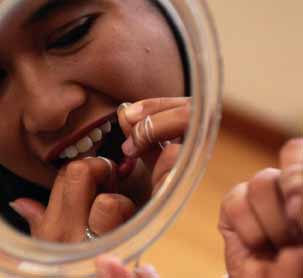In this section
Dental
- Dental and oral health
- Adolescent problems of the teeth and mouth
- Anatomy and development of the mouth and teeth
- Dental health overview
- Flossing
- Fluoride
- Hand-foot-and-mouth disease
- Herpangina
- Herpes simplex virus cold sores
- Infant problems of the teeth and mouth
- Malocclusion
- Nursing bottle caries
- Oral health and dental specialists
- Periodontal disease
- Prevention of oral problems
- Teething
- Thrush or candidiasis
- Thumb sucking
- Toddler problems of the teeth and mouth
- Dental procedures
- Contact us
- Children with special healthcare needs
- Our specialists
- Locations
- Dental health resources
Flossing
Flossing should be started when your child is around 2 to 3 years of age, under the direction of your child's dentist. Prior to this age, flossing is not necessary. Children usually need assistance with flossing until they are 8 to 10 years of age.
The importance of flossing:

Brushing teeth properly and consistently helps to remove most dental plaque, however, brushing alone cannot remove plaque that is located in places that a toothbrush cannot reach, particularly in-between teeth. In addition to removing plaque, flossing also helps to:
- Remove debris that adheres to teeth and gums in-between teeth
- Polish tooth surfaces
- Control bad breath
Flossing should take place at least once a day for two to three minutes each time to be most effective.
Types of dental floss:
Regular, consistent flossing is the single most important weapon against plaque, perhaps more important than the toothbrush. The different types of dental floss include the following:
- Waxed and unwaxed
- Flavored and unflavored
- Wide and regular
Flossing methods:
 Your child's dentist or other oral healthcare provider can provide a demonstration of any of the following flossing techniques. They include:
Your child's dentist or other oral healthcare provider can provide a demonstration of any of the following flossing techniques. They include:
- Spool method (also called the finger-wrap method) - Cut off a piece of floss that is approximately 18 to 20 inches in length. Lightly wrap each side of the piece of floss several times around each middle finger. Next, carefully maneuver the floss in-between the teeth with your index fingers and thumbs in an up and down, not side-to-side motion. It is best to bring the floss up and down making sure to go below the gumline, forming a "C" on the side of each tooth.
- Loop method (also called the circle method) - Cut off a piece of floss that is approximately 18 inches long, and tie it securely in a circle. Next, place all of the fingers, except the thumb, within the loop. Then, use your index fingers to guide the floss through the lower teeth, and use your thumbs to guide the floss through the upper teeth, making sure to go below the gumline, forming a "C" on the side of each tooth.
Other flossing techniques:
Flossing tools, such as a prethreaded flosser or floss holder may be helpful for people who are just learning how to floss, individuals with limited dexterity in their arms and/or hands, or persons who are flossing the teeth of someone else (particularly a child or disabled person).
Irrigating devices, such as waterpicks, are not considered a substitute for brushing and flossing. These devices may be effective around orthodontic braces that retain food or in areas a toothbrush cannot reach. However, they do not remove plaque.
